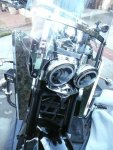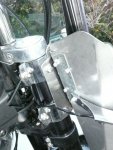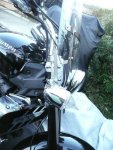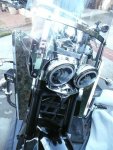AFAIK (IIRC) Triumph screens are made by National Cycle - So are MAYBE polycarbonate.
Clearview are I think acrylic.
Most others I have ever looked at are cast acrylic. If they come from an aircraft place they'll probably be acrylic.
This last gem from my mate Jim in the US who had an aircraft restoration business.
I was idly looking about today to see if I could find an Original Triumph blade - but could only find the summer variety.
If I suddenly had to replace the Triumph screen I would almost certainly get that National Cycle for Suzuki thing. But I'd get a dark one.
It's not ALL bad news
Acrylic vs. Polycarbonate: a Quantitative and Qualitative Comparison –
I think that link content is worth posting in entirety as it is good simple and not too large and I get frustrated when trying to find old links that they disappear out of my humble IT ability to recover them.
ACRYLIC VS. POLYCARBONATE: A QUANTITATIVE AND QUALITATIVE COMPARISON
Acrylic often compared to Polycarbonate, which is an other transparent plastic, that is sometimes used for bearing loads. Polycarbonate is sometimes called Lexan®, which is a trademark by GE Plastics. An other popular brand name for Polycarbonate is Makrolon®, owned by Bayer. Acrylic on the other hand is often called Plexiglas. Plexiglas ® is a trademark by Roehm and Hass.
Popular Uses for Acrylic (Plexiglas):
- Motorcycle helmet visors
- Helicopter Windows, Submarine Windows
- Spectator protection in ice hockey
- Police riot control vehicles modifications
- Swimming Pool Windows
- Aquariums and Terariums (including large public aquarium walls and tunnels)
Popular Uses for Polycarbonate (Lexan):
- Compact discs, DVDs
- Lighting lenses, sun-glass/eyeglass lenses, safety glasses, automotive headlamp lenses, camper windows
- Drinking bottles
- Computers: Apple, Inc.’s MacBook, iMac, and Mac mini
- Cases
- Riot shields, visors
- Instrument panels
- Bullet-proof Glass
Key characteristics, Acrylic compared to Polycarbonate:
- More likely to chip
- less impact resistance then Polycarbonate, but still 10-24 times more resistant than float glass
- more resistant against evenly distributed loads then Polycarbonate
- Less likely to scratch.
- Does NOT yellow after time.
- Better clarity. Acrylic can be restored to optical clarity by polishing.
Key characteristics, Polycarbonate compared to Acrylic:
- Impact/chip resistance is much higher with Polycarbonate. (about 30 times more resistant than glass)
- More likely to scratch.
- Substantially more expensive. (roughly 2 to 3 times)
- Used for more industry applications
- Bulletproof when thick enough.
- More bendable under normal temperatures (0-20°C)
- Yellows over time due to ultraviolet rays
- Easier to work with (cut, less likely to break)
- Poorer clarity, diffuses light
Polycarbonate – Lexan Acrylic – Plexiglas GS
Density g/cm³ 1.2 1.19
Max weight gain during immersion % 0.35 2.1
Tensile strength σΜ at 23°C MPa 60-70 80
Flexural strength σbB MPa 90 115
Impact strength acU (Charpy) kJ/m2 35 15
Flexural strength σbB MPa 90 115
Optical Light Transmission % 89 92
Forming Temperature °C 185…205 160…175
Vicat B Temperature °C 145 115
Velocity of Sound m/min 2270 2750
Attenuation at 5MHz dB/cm 24.9 6.4
Fire Rating German DIN 4102 B2 B2 (*2)
Sources:
Lexan 9030 Sheet Product Datasheet
Plexiglas GS Product Description
(*2): Makrolon AR – Bayer Sheet Europe, October 2004
Categories: Technology of Glazing under Pressure
Created: 28 July 2014
Last Modified: 26 May 2015




